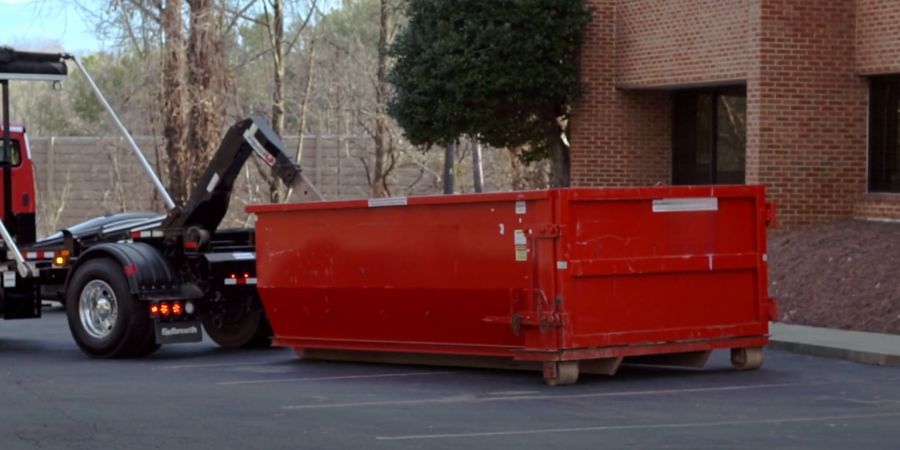
A roll off dumpster can accommodate a wide variety of materials, from construction debris and household junk to yard waste and general trash, though specific regulations vary by location and rental company.
Understanding what’s allowed helps you avoid additional fees and ensure proper waste disposal while maximizing the value of your dumpster rental. Most rental companies provide clear guidelines about acceptable materials, weight limits, and prohibited items to ensure safe and efficient waste management.
Understanding Roll Off Dumpster Basics
Roll off dumpsters serve as temporary waste containers designed for both residential and commercial projects. These containers feature an open-top design and wheels that allow them to be easily delivered and retrieved. The term “roll off” comes from the truck’s ability to roll the dumpster off its hydraulic lift system, positioning it precisely where needed on your property.
Common Dumpster Sizes and Available Capacity
| Size (Cubic Yards) | Typical Use | Weight Limit (lbs) |
|---|---|---|
| 10 | Small renovations | 2,000-4,000 |
| 20 | Medium projects | 4,000-6,000 |
| 30 | Large remodels | 6,000-8,000 |
| 40 | Construction sites | 8,000-10,000 |
Acceptable Materials for Roll Off Dumpster Disposal
Understanding what materials are allowed in your roll off dumpster helps ensure smooth project completion and avoid additional fees. Most rental companies accept a broad range of common materials, though specific policies may vary.
Construction and Demolition Debris
Construction and renovation projects generate significant waste that’s typically acceptable for roll off dumpster disposal. Common materials include:
| Material Type | Examples | Special Considerations |
|---|---|---|
| Wood Products | Lumber, plywood, trim | Remove nails when possible |
| Drywall | Sheetrock, plaster | May have weight restrictions |
| Flooring | Carpet, tile, hardwood | Bundle for efficient loading |
| Roofing | Shingles, underlayment | Check weight limits |
Household Items and General Waste
Most household items can be disposed of in roll off dumpsters, making them perfect for decluttering, moving, or estate cleanouts. Acceptable materials typically include furniture, appliances (with proper preparation), and general household goods.
Prohibited Materials in Roll Off Dumpsters
While roll off dumpsters accept many types of waste, certain materials are universally prohibited due to environmental regulations, safety concerns, or disposal requirements.
Hazardous Materials
Hazardous materials require specialized disposal methods and are never permitted in standard roll off dumpsters. These include:
- Paint, solvents, and other chemicals
- Automotive fluids and oils
- Pesticides and fertilizers
- Batteries
- Asbestos-containing materials
Electronic Waste Restrictions
Electronic waste often contains hazardous components and requires specific disposal methods. Common restricted electronics include:
- Computers and laptops
- Television sets
- Mobile phones
- Printers and copiers
Weight Limits and Loading Guidelines
Proper loading techniques and weight distribution are crucial for safe and efficient roll off dumpster use. Understanding and following these guidelines helps prevent additional charges and ensures safe transport.
Proper Loading Techniques
When loading your roll off dumpster, follow these essential practices:
- Distribute weight evenly throughout the container
- Break down large items when possible
- Load heavy items first
- Don’t exceed the container’s walls
- Keep hazardous materials separate
Special Considerations and Local Regulations
Local regulations and rental company policies can affect what’s allowed in your roll off dumpster. Understanding these requirements helps avoid complications and additional fees.
Municipal Guidelines
Many municipalities have specific requirements regarding:
- Recycling requirements
- Permit needs
- Placement restrictions
- Operating hours
- Weight limits
Environmental Compliance
Environmental regulations may restrict certain materials:
- Clean fill requirements
- Recycling mandates
- Contamination prevention
- Stormwater protection
- Special waste handling
Maximizing Your Roll Off Dumpster Rental
To get the most value from your roll off dumpster rental, consider these strategies:
- Plan your project carefully
- Sort materials before loading
- Break down large items
- Schedule delivery at optimal times
- Understand all fees and policies
Conclusion
Understanding what’s allowed in a roll off dumpster helps ensure successful project completion while avoiding additional fees and complications. By following proper guidelines, sorting materials appropriately, and working with your rental provider, you can maximize the efficiency of your waste disposal project while maintaining environmental compliance and safety standards.
Roll Off Dumpster FAQs
What Size Roll Off Dumpster Do I Need for a Kitchen Remodel?
For a typical kitchen remodel, a 20-yard roll off dumpster is usually sufficient to handle the debris from cabinets, countertops, appliances, and other materials. This size provides enough capacity for most kitchen renovations while remaining cost-effective.
Can You Put Old Appliances in a Roll Off Dumpster?
Most roll off dumpster companies do accept appliances, but they typically require proper preparation such as removing doors, draining fluids, and removing refrigerants from units that contain them. Some providers may charge additional fees for appliance disposal.
How Long Can You Keep a Roll Off Dumpster?
Standard rental periods for roll off dumpsters typically range from 7-10 days, though many companies offer flexible rental extensions for an additional fee. The specific rental duration depends on your project needs and the rental company’s policies.
Do You Need a Permit for a Roll Off Dumpster?
Whether you need a permit for a roll off dumpster depends on where you plan to place it – if the dumpster will be on public property like a street or sidewalk, most cities require a permit. However, permits are generally not required when placing the dumpster on private property.
How Much Space Do You Need for a Roll Off Dumpster?
For a roll off dumpster placement, you typically need a clear area that’s at least 22 feet long, 8 feet wide, and 14 feet high to accommodate both the dumpster and delivery truck. The exact space requirements may vary based on dumpster size and local conditions.